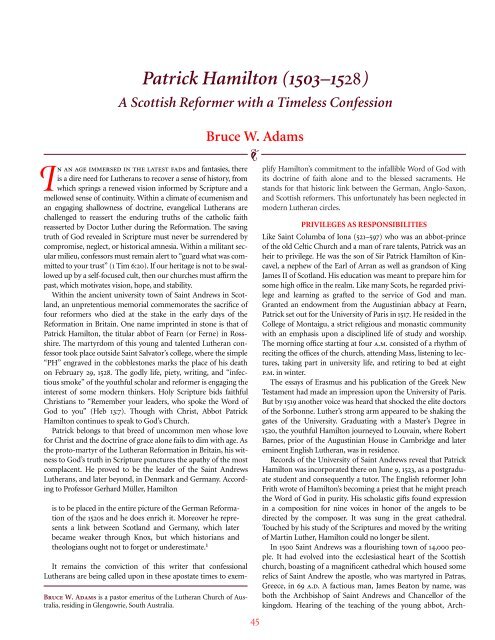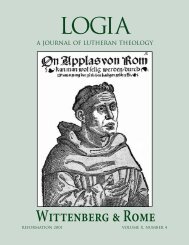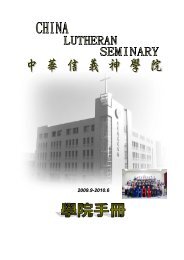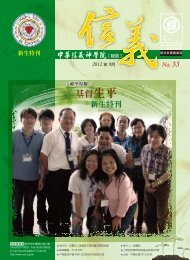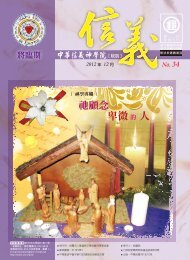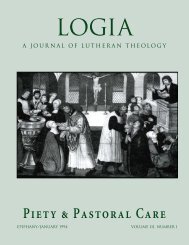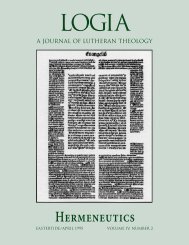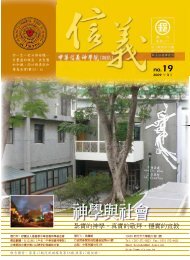05-4 Theology of the..
05-4 Theology of the..
05-4 Theology of the..
You also want an ePaper? Increase the reach of your titles
YUMPU automatically turns print PDFs into web optimized ePapers that Google loves.
Patrick Hamilton (1503–1528)<br />
A Scottish Reformer with a Timeless Confession<br />
IN AN AGE IMMERSED IN THE LATEST FADS and fantasies, <strong>the</strong>re<br />
is a dire need for Lu<strong>the</strong>rans to recover a sense <strong>of</strong> history, from<br />
which springs a renewed vision informed by Scripture and a<br />
mellowed sense <strong>of</strong> continuity. Within a climate <strong>of</strong> ecumenism and<br />
an engaging shallowness <strong>of</strong> doctrine, evangelical Lu<strong>the</strong>rans are<br />
challenged to reassert <strong>the</strong> enduring truths <strong>of</strong> <strong>the</strong> catholic faith<br />
reasserted by Doctor Lu<strong>the</strong>r during <strong>the</strong> Reformation. The saving<br />
truth <strong>of</strong> God revealed in Scripture must never be surrendered by<br />
compromise, neglect, or historical amnesia. Within a militant secular<br />
milieu, confessors must remain alert to “guard what was committed<br />
to your trust” (1 Tim 6:20). If our heritage is not to be swallowed<br />
up by a self-focused cult, <strong>the</strong>n our churches must affirm <strong>the</strong><br />
past, which motivates vision, hope, and stability.<br />
Within <strong>the</strong> ancient university town <strong>of</strong> Saint Andrews in Scotland,<br />
an unpretentious memorial commemorates <strong>the</strong> sacrifice <strong>of</strong><br />
four reformers who died at <strong>the</strong> stake in <strong>the</strong> early days <strong>of</strong> <strong>the</strong><br />
Reformation in Britain. One name imprinted in stone is that <strong>of</strong><br />
Patrick Hamilton, <strong>the</strong> titular abbot <strong>of</strong> Fearn (or Ferne) in Rossshire.<br />
The martyrdom <strong>of</strong> this young and talented Lu<strong>the</strong>ran confessor<br />
took place outside Saint Salvator’s college, where <strong>the</strong> simple<br />
“PH” engraved in <strong>the</strong> cobblestones marks <strong>the</strong> place <strong>of</strong> his death<br />
on February 29, 1528. The godly life, piety, writing, and “infectious<br />
smoke” <strong>of</strong> <strong>the</strong> youthful scholar and reformer is engaging <strong>the</strong><br />
interest <strong>of</strong> some modern thinkers. Holy Scripture bids faithful<br />
Christians to “Remember your leaders, who spoke <strong>the</strong> Word <strong>of</strong><br />
God to you” (Heb 13:7). Though with Christ, Abbot Patrick<br />
Hamilton continues to speak to God’s Church.<br />
Patrick belongs to that breed <strong>of</strong> uncommon men whose love<br />
for Christ and <strong>the</strong> doctrine <strong>of</strong> grace alone fails to dim with age. As<br />
<strong>the</strong> proto-martyr <strong>of</strong> <strong>the</strong> Lu<strong>the</strong>ran Reformation in Britain, his witness<br />
to God’s truth in Scripture punctures <strong>the</strong> apathy <strong>of</strong> <strong>the</strong> most<br />
complacent. He proved to be <strong>the</strong> leader <strong>of</strong> <strong>the</strong> Saint Andrews<br />
Lu<strong>the</strong>rans, and later beyond, in Denmark and Germany. According<br />
to Pr<strong>of</strong>essor Gerhard Müller, Hamilton<br />
is to be placed in <strong>the</strong> entire picture <strong>of</strong> <strong>the</strong> German Reformation<br />
<strong>of</strong> <strong>the</strong> 1520s and he does enrich it. Moreover he represents<br />
a link between Scotland and Germany, which later<br />
became weaker through Knox, but which historians and<br />
<strong>the</strong>ologians ought not to forget or underestimate. 1<br />
It remains <strong>the</strong> conviction <strong>of</strong> this writer that confessional<br />
Lu<strong>the</strong>rans are being called upon in <strong>the</strong>se apostate times to exem-<br />
BRUCE W. ADAMS is a pastor emeritus <strong>of</strong> <strong>the</strong> Lu<strong>the</strong>ran Church <strong>of</strong> Australia,<br />
residing in Glengowrie, South Australia.<br />
Bruce W. Adams<br />
<br />
45<br />
plify Hamilton’s commitment to <strong>the</strong> infallible Word <strong>of</strong> God with<br />
its doctrine <strong>of</strong> faith alone and to <strong>the</strong> blessed sacraments. He<br />
stands for that historic link between <strong>the</strong> German, Anglo-Saxon,<br />
and Scottish reformers. This unfortunately has been neglected in<br />
modern Lu<strong>the</strong>ran circles.<br />
PRIVILEGES AS RESPONSIBILITIES<br />
Like Saint Columba <strong>of</strong> Iona (521–597) who was an abbot-prince<br />
<strong>of</strong> <strong>the</strong> old Celtic Church and a man <strong>of</strong> rare talents, Patrick was an<br />
heir to privilege. He was <strong>the</strong> son <strong>of</strong> Sir Patrick Hamilton <strong>of</strong> Kincavel,<br />
a nephew <strong>of</strong> <strong>the</strong> Earl <strong>of</strong> Arran as well as grandson <strong>of</strong> King<br />
James II <strong>of</strong> Scotland. His education was meant to prepare him for<br />
some high <strong>of</strong>fice in <strong>the</strong> realm. Like many Scots, he regarded privilege<br />
and learning as grafted to <strong>the</strong> service <strong>of</strong> God and man.<br />
Granted an endowment from <strong>the</strong> Augustinian abbacy at Fearn,<br />
Patrick set out for <strong>the</strong> University <strong>of</strong> Paris in 1517. He resided in <strong>the</strong><br />
College <strong>of</strong> Montaigu, a strict religious and monastic community<br />
with an emphasis upon a disciplined life <strong>of</strong> study and worship.<br />
The morning <strong>of</strong>fice starting at four A.M. consisted <strong>of</strong> a rhythm <strong>of</strong><br />
reciting <strong>the</strong> <strong>of</strong>fices <strong>of</strong> <strong>the</strong> church, attending Mass, listening to lectures,<br />
taking part in university life, and retiring to bed at eight<br />
P.M. in winter.<br />
The essays <strong>of</strong> Erasmus and his publication <strong>of</strong> <strong>the</strong> Greek New<br />
Testament had made an impression upon <strong>the</strong> University <strong>of</strong> Paris.<br />
But by 1519 ano<strong>the</strong>r voice was heard that shocked <strong>the</strong> elite doctors<br />
<strong>of</strong> <strong>the</strong> Sorbonne. Lu<strong>the</strong>r’s strong arm appeared to be shaking <strong>the</strong><br />
gates <strong>of</strong> <strong>the</strong> University. Graduating with a Master’s Degree in<br />
1520, <strong>the</strong> youthful Hamilton journeyed to Louvain, where Robert<br />
Barnes, prior <strong>of</strong> <strong>the</strong> Augustinian House in Cambridge and later<br />
eminent English Lu<strong>the</strong>ran, was in residence.<br />
Records <strong>of</strong> <strong>the</strong> University <strong>of</strong> Saint Andrews reveal that Patrick<br />
Hamilton was incorporated <strong>the</strong>re on June 9, 1523, as a postgraduate<br />
student and consequently a tutor. The English reformer John<br />
Frith wrote <strong>of</strong> Hamilton’s becoming a priest that he might preach<br />
<strong>the</strong> Word <strong>of</strong> God in purity. His scholastic gifts found expression<br />
in a composition for nine voices in honor <strong>of</strong> <strong>the</strong> angels to be<br />
directed by <strong>the</strong> composer. It was sung in <strong>the</strong> great ca<strong>the</strong>dral.<br />
Touched by his study <strong>of</strong> <strong>the</strong> Scriptures and moved by <strong>the</strong> writing<br />
<strong>of</strong> Martin Lu<strong>the</strong>r, Hamilton could no longer be silent.<br />
In 1500 Saint Andrews was a flourishing town <strong>of</strong> 14,000 people.<br />
It had evolved into <strong>the</strong> ecclesiastical heart <strong>of</strong> <strong>the</strong> Scottish<br />
church, boasting <strong>of</strong> a magnificent ca<strong>the</strong>dral which housed some<br />
relics <strong>of</strong> Saint Andrew <strong>the</strong> apostle, who was martyred in Patras,<br />
Greece, in 69 A.D. A factious man, James Beaton by name, was<br />
both <strong>the</strong> Archbishop <strong>of</strong> Saint Andrews and Chancellor <strong>of</strong> <strong>the</strong><br />
kingdom. Hearing <strong>of</strong> <strong>the</strong> teaching <strong>of</strong> <strong>the</strong> young abbot, Arch-


